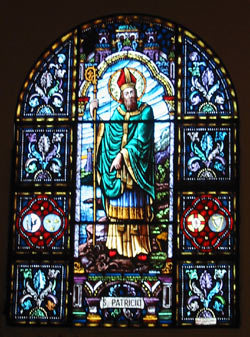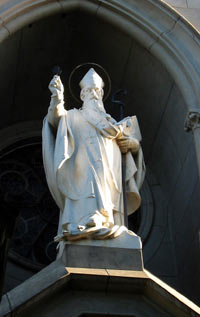|
Theoretical considerations
In order
to study the processes of traditionalisation and inversion of
traditions in the urban sphere, we take as our focal point the
specific case of St. Patrick’s Day in Buenos Aires in 2005 and
its redefinition in 2006. We contextualise this event within
the processes of the appropriation of public space connected
to consumerism, which allow us to demonstrate the
socio-cultural transformations which are currently taking
place in Buenos Aires (Martín 2005), examined within the
disciplinary field of folk-tradition.
|

Stained-glass window in
St. Patrick's chapel at
Santa Lucía, district of San Pedro,
province of Buenos Aires
(Edmundo Murray, January 2003)
|
We use the
concept of ‘performance’ as defined by Richard Bauman
(1975, 1986) in the sense of a form of aesthetically marked
communication, carried out in a concrete socio-historical
context and before an audience that assesses its communicative
effectiveness. We consider the aforementioned celebration an
event of folk-tradition performance, with certain aesthetic
characteristics which will be analysed in this paper. We can
characterise the traditional folk message as the spontaneous
expression of a group’s differential identity (Bauman 1974),
constructed as such by means of a contrasting comparison with
other groups in a determined social context. [1]
We emphasise the
processual dimension of traditions (Fine 1989, Handler y
Linnekin 1984), signifying a dynamic performance of the past
undertaken in the present and, in this sense, we pay special
attention to the ‘invention’ of tradition (Hobsbawn 1983),
linked to the poetic reconstruction of historical subject
matter (White 1988). Such a reconstruction, according to our
hypothesis, relates to the act of redefining significance and
symbols such as the emblematic figure of St. Patrick, in new
contexts of expression.
With these
theoretical bases, we compiled an archive of material relating
to the celebration of St. Patrick’s Day, understanding archive
in the etymological sense of arkhé or principle of
organising the past and memory (Derrida, 1997). In putting
together this archive, we adopted a genetic hypertextual focus
(Palleiro 2004a 2004b) which proposes a means of ordering
materials capable of reflecting its own process, leaving the
marks of the dynamic of construction or genesis and its
itineraries of circulation visible, similar to those of a
virtual hypertext, which reflect the flexible connective
structure of the processes of memory construction (Assmn
1997).
Starting
with this archive, we proposed an analytical route through the
main points of the history and legend in the medieval
tradition, the immigrant communities of the American continent
and the plural convergence of identities and memories in St.
Patrick’s Day in Buenos Aires, as shown in the different areas
of celebration: from religious services to street parties and
Celtic festivals; the processes of the carnivalesque inversion
and reversion of the canonical celebration in the street
celebration; the marketing of the celebration in advertising
discourse, and the comments on the event in the virtual fora
of the internet. All these aspects, which we will briefly
summarise in what follows, were approached in a more detailed
manner in our research, which has been published.
A new
contribution which we would like to outline in this paper, as
a means of proposal for a diachronic study of the event in
relation to the redefinition of Ireland’s patron saint’s day
in the Argentine context, is to point out some of the
transformations that have taken place in 2006, which
correspond to the position adopted by Argentina’s Irish
community regarding the events of 2005.
St.
Patrick: history and legend in medieval tradition
Regarding
the historical existence of the saint, we can situate his
birth in the year 389 into the heart of a family of Welsh
origin, and his life as a slave from the age of sixteen in
Ireland until his escape to Italy by ship six years later.
There he was ordained a priest, later returning to Ireland to
evangelise on the island. His preaching and work as a priest
continued up to his death on 17 March 464. Woodeene
Koenig-Bricker (1996), author of 365 Saints: Your daily
guide to the wisdom and wonder of their lives,
presents the emblematic figure of St. Patrick as ‘someone
whose life contains as much fiction as fact’. In the same way
the religious literature faces us with the problem of the
crossovers between fiction and reality, as emphasised in the
historiography of Hayden White (1988) in his thoughts on the
‘poetics of history’, and by Roland Barthes (1970) in literary
theory in his studies on ‘the illusion of reality’. This theme
was one of the focal points of Palleiro’s doctoral thesis
(1993), dedicated to the study of the methods of
fictionalisation of historical context in traditional
narrative discourse.
The
character of the saint who, in his role as paradigmatic
figure, legitimises the popular celebration in its
articulation between history, fiction and legend, is one of
the main aspects of our research. This problem leads us to
consider his links to exemplary literature, tackled by Susan
Suleiman (1977), among others, in her paper ‘History as
example, and example as history’. For his part, the
medievalist Welter (1927), in his work on exemplary literature
in the Middle Ages, defines the enxemplo as an ‘account'
or 'story', 'fable' or 'parable', 'anecdote' or account used to
support a doctrinal, religious or moral statement. He
thus emphasises the dependence of the enxemplo, as a
type of discourse, in relation to doctrinal teachings, which
can also be seen in our archive in the sermons of the
liturgical celebrations of St. Patrick in Buenos Aires, where
the story of the saint’s life is used as a pretext for
preaching a doctrine. We therefore include, as part of our
archive, different versions of the saint’s life taken from
hagiographic writings, whose most distinctive feature is the
intertextual framework between a written register and oral
tradition. Such texts interweave fictional elements
characteristic of legendary discourse – whose defining feature
is a fictional elaboration of belief (Dégh y Vászonyi 1976)-
with a canonical discourse which legitimises the figure of the
saint as a paradigmatic model, composed of an emblematic
concentration of ‘Christian virtue’. In the celebration of St.
Patrick’s Day in Buenos Aires, this line of argument from
exemplary literature will be taken up again in the sermons of
the liturgical celebrations.
|

St. Patrick's church
at
San Antonio de Areco,
province of Buenos Aires
(Edmundo Murray, January 2003)
|
The
celebration of St. Patrick in the European context and its re-traditionalisation
in America
Taking the
concept of the ‘invention’ of traditions as a starting point (Hobsbawn
1983), concerning the processes of redefining elements of the
traditional culture of certain groups in different contexts,
we wish to emphasise the journey of St. Patrick’s Day
celebrations from Europe to the American continent and its
links to migratory movements. Due to spatial constraints, we
will only mention the celebrations in Québec and Mexico City,
by way of comparison with the celebrations in Ireland.
St.
Patrick’s Day grew more important outside Ireland when Irish
immigrants, as a minority group, faced the problem of
differentiating themselves from other European ethnic groups
with whom they shared a number of customs. In this way the
celebrations acquired a value as a symbol of differential
identity (Bauman 1974).
This is
what happened in the Québec area where the English-speaking
Irish found themselves in a unique linguistic context among
the predominant French-speaking population and, as speaking
English naturally distanced them from the majority, they did
not feel the need to use the Gaelic language as an ethnic
signifier (Schmitz 1991). Within its particular religious
context, their Catholicism placed them in a subordinate
position in relation to the dominant Protestantism of the
English and Scottish. Nevertheless, the rapid recognition of
the civil rights of the Francophone French population which
followed the British conquest, the presence of Irish people in
different social strata and their marriage to French people,
were all factors that prevented the formation of a ghetto
situation in Québec. Thus, with the passing of time, it was
more and more difficult to proclaim a ‘purist’ ancestry among
the numerous Irish, which allows us establish a certain
parallel with the Irish community in Buenos Aires. Nowadays,
the assimilation of the Irish has acquired a greater dynamism
and St. Patrick’s Day has been incorporated into the
‘tradition’ of urban celebrations in the city of Québec, where
anyone can be ‘Irish for a day’.
For its
part, the celebration of St. Patrick’s Day in Mexico City
appears on the internet’s virtual network as an ‘Irish party’
with a global dimension, in contrast to the deep-rooted local
folk celebrations such as the Day of the Dead. The name of
Ireland’s patron saint is used by an Irish battalion, the St.
Patrick’s Battalion, as an emblem of the courage and heroism
of a group of Irishmen, considered martyrs, who gave their
lives for the Mexican cause during the North American invasion
of 1847. In Argentina also, the saint was associated with
Irishmen who took up arms and defended the nation, such as
William Brown. In sum, the dynamic between local and global
and the union of the patron saint of Ireland with emblems of
nationality can also be seen in the celebration of St.
Patrick’s Day in Buenos Aires in 2006, which is this article’s
main point of interest, from the point of view of the analysis
of the diachronic changes in regard to the celebrations in
previous years, and tackling the specificities of this
historical context. |


